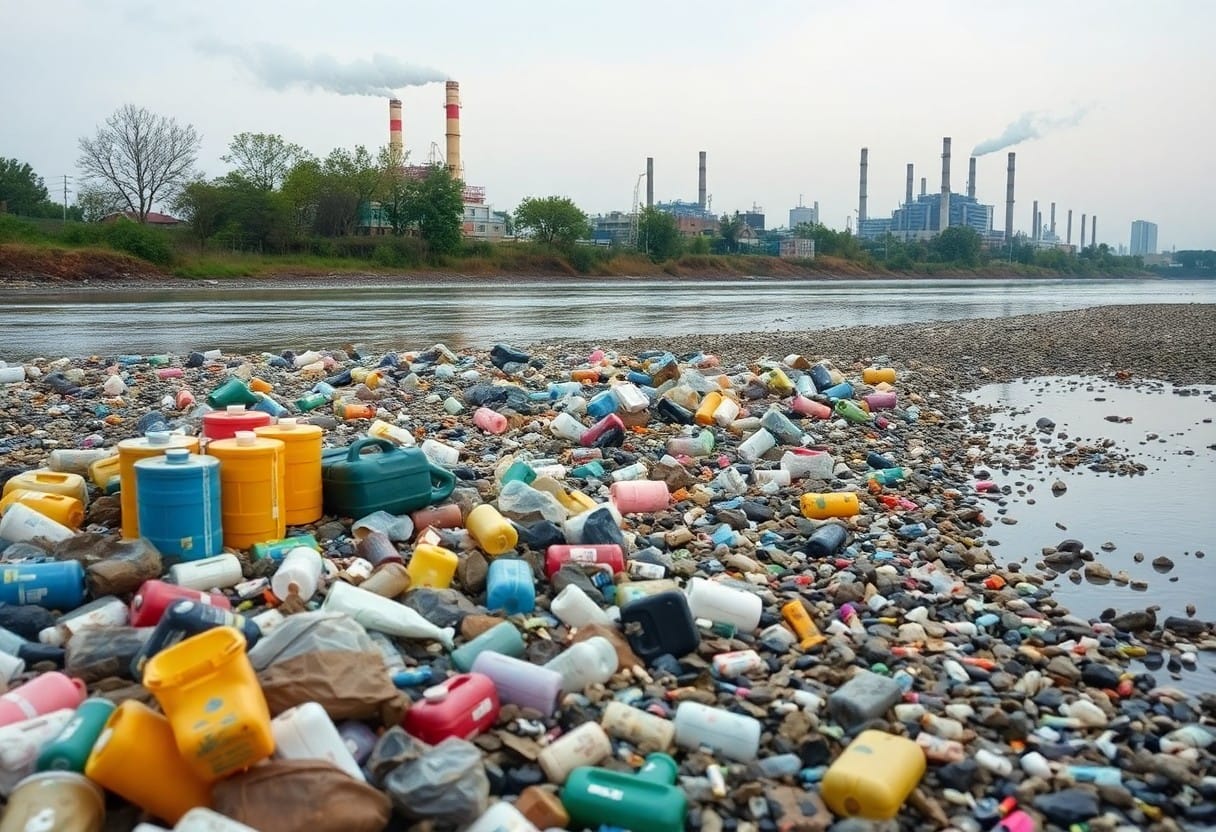PFAS, or per- and polyfluoroalkyl substances, are chemicals that have increasingly contaminated water supplies across the nation. You may not realize that these persistent pollutants come from everyday products like non-stick cookware and water-resistant clothing, making them difficult to avoid. Your city’s water may be affected, posing risks to your health and the environment. Understanding the sources and impacts of PFAS is crucial for taking action and advocating for solutions that prioritize the well-being of your community.
Understanding PFAS
The issue of PFAS (per- and polyfluoroalkyl substances) has garnered significant attention due to its potential health risks. These are a group of human-made chemicals that contain fluorine, known for their ability to repel water and oil. Often referred to as “forever chemicals,” PFAS have been widely used in various products, from non-stick cookware to water-resistant clothing, leading to persistent environmental contamination.
Definition and Chemical Properties
Against a backdrop of increasing environmental concerns, PFAS are defined by their strong carbon-fluorine bonds, which make them highly resistant to degradation. This durability is what allows them to persist in the environment and accumulate in human and animal bodies, leading to potential adverse health effects.
Sources of PFAS Contamination
Above ground, myriad sources contribute to PFAS contamination, including industrial discharges, wastewater treatment plants, and even consumer products. Understanding these sources can help you identify the potential risks in your environment and take necessary precautions.
In addition to industrial discharges and wastewater treatment plants, firefighting foams and certain food packaging materials are significant contributors to PFAS pollution. When these foams are used during training exercises or actual incidents, they can leach PFAS into soil and groundwater. Furthermore, food products packaged in PFAS-treated materials can lead to direct contamination of your food supply. Identifying these sources is vital to mitigating your exposure and protecting your health.

Health Impacts of PFAS
Assuming you live in an area affected by PFAS contamination, it’s important to understand the risks these substances pose to your health. PFAS, often referred to as “forever chemicals,” can accumulate in your body over time, leading to a range of health issues that can significantly impact your well-being.
Short-term Exposure Risks
The most immediate risks associated with short-term exposure to PFAS include skin irritation, respiratory issues, and gastrointestinal disturbances. These symptoms can manifest after contact with contaminated water or food, potentially leading to discomfort and reduced quality of life.
Long-term Health Consequences
To fully grasp the dangers of long-term exposure, you should be aware that PFAS are linked to serious health issues, including cancer, liver damage, and immune system dysfunction. Research shows that these chemicals can disrupt hormonal regulation and may lead to reproductive problems.
This accumulation of PFAS in your body can lead to numerous significant health risks. Studies have indicated that individuals exposed to PFAS over prolonged periods face an increased likelihood of developing kidney and testicular cancer. Furthermore, long-term exposure has been associated with thyroid disease, high cholesterol, and potential effects on fetal development, impacting children’s health even before birth. Understanding these risks is imperative for you to take proactive steps towards safeguarding your health and that of your family.
Regulatory Landscape
Even as awareness of PFAS contamination grows, the regulatory landscape surrounding these substances remains complex and often fragmented. Many states have started to set their own standards, leading to a patchwork of regulations that can leave you confused about what is safe in your community. Federal guidelines have been slow to evolve, indicating a need for more cohesive policies to effectively tackle the PFAS problem in your city.
Current Regulations and Guidelines
On the federal level, the U.S. Environmental Protection Agency (EPA) has issued some guidelines for PFAS, but these recommendations often fall short of establishing enforceable limits. Most states have adopted their own regulations, yet many communities still lack the necessary safeguards to protect you and your environment from harmful exposure.
Challenges in Enforcement
With regulations varying widely, enforcing PFAS standards poses significant hurdles for local governments and agencies. Most are under-resourced and lack the robust testing methods to accurately detect these contaminants, which complicates their ability to take timely action to protect you.
For instance, many health departments are struggling to secure funding for comprehensive monitoring programs, leaving your community vulnerable to undetected PFAS pollution. Additionally, the scientific complexities surrounding PFAS compounds and their varying effects can make it difficult for agencies to establish clear and actionable regulations. These challenges create a scenario where, without vigilance and advocacy from you, effective enforcement may lag, leaving potential risks unaddressed in your environment.
Local Case Studies
Unlike many environmental issues, PFAS contamination presents unique challenges that can be observed in various cities. Here are some notable case studies:
- Huntsman Chemical Company in Texas: Discharged over 2,000 gallons of PFAS into the San Jacinto River.
- Newark, New Jersey: PFAS levels were found at 70 ppt, prompting emergency water supply measures.
- Flint, Michigan: Residents faced high PFAS levels amid the ongoing water crisis.
- Parkersburg, West Virginia: Reported 3M’s production led to widespread PFAS contamination in communities.
Cities Affected by PFAS
Cities across the nation are grappling with PFAS contamination. You may find that urban and rural areas alike have detected these harmful substances in their water supplies, with some locations reporting levels exceeding the recommended safety limits.
Community Responses
Across the United States, communities are actively working to address the PFAS crisis. Local leaders and citizens are engaging in robust advocacy for regulatory change and better water management practices.
At the community level, advocacy groups are mobilizing efforts to raise awareness about PFAS risks, leading to initiatives like water testing drives and the installation of filtration systems in homes. These proactive measures aim to ensure safe drinking water while pushing for stricter regulations on industrial discharges. Engaging local media, communities are spotlighting legal action against manufacturers contributing to the contamination, emphasizing the need for accountability and lasting solutions.
Mitigation Strategies
To effectively combat PFAS contamination, cities need to implement comprehensive mitigation strategies. These can include advanced treatment technologies, community engagement programs, and strict regulations on industrial discharges. You should advocate for a coordinated approach that involves various stakeholders to ensure the safety and health of your community.
Filtration and Remediation Techniques
One effective way to reduce PFAS levels is through advanced filtration and remediation techniques such as activated carbon, ion exchange, and reverse osmosis. These technologies can remove PFAS from drinking water sources, helping to ensure that you have access to clean and safe water. Implementing these methods at both municipal and point-of-use levels can significantly mitigate exposure risks.
Policy Recommendations
Recommendations for effective PFAS management include the adoption of regulatory frameworks that set limits on PFAS levels in water and soil. Cities should engage in transparency by informing you about contamination levels and remediation efforts. By advocating for stronger regulations and funding for research on PFAS impacts, you can play a vital role in shaping public policy.
Strategies for addressing PFAS include developing comprehensive regulations that prioritize public health and environmental protection. Legislation should mandate routine testing of drinking water and swift remediation actions when contamination is found. You can support initiatives aimed at restricting the use of hazardous substances containing PFAS and promote funding for alternative materials in industries that commonly use them. By pursuing these strategies, you can help lead your community toward a safer future.
Public Awareness and Advocacy
For you to effectively address the PFAS problem in your community, public awareness and advocacy are necessary. Educating yourself and others about the dangers of these substances can drive change and promote healthier environmental practices. By understanding the risks associated with PFAS, you can advocate for better regulations, cleanup initiatives, and support for affected communities. Your voice can push local governments and industries to take responsibility, ultimately leading to a safer environment for everyone.
Community Engagement Efforts
Before entering into solutions, it’s important for you to engage with your community on the issue of PFAS. Organizing forums, workshops, and information sessions can help raise awareness among your neighbors, enabling everyone to make informed decisions about their health and environment. By forming coalitions and partnerships with local organizations, you can amplify your efforts and foster a united front against PFAS contamination.
Role of Nonprofits and Activists
Role of nonprofits and activists is significant in combating PFAS pollution. They work diligently to highlight the dangers of these chemicals, often mobilizing communities and creating educational resources to inform you and your neighbors. Through advocacy campaigns and grassroots organizing, these entities aim to influence policy changes to protect your communities from further contamination.
A growing number of nonprofit organizations and activists are dedicated to addressing the PFAS crisis, empowering you to take action. They provide vital resources, including guides on testing water quality and information on local regulations, making it easier for you to understand potential risks. By advocating for stronger environmental protections and legislation, these groups work tirelessly to ensure that your voices are heard and that companies are held accountable for their actions. Their efforts can lead to positive changes that directly impact your health and the safety of your community.
To wrap up
To wrap up, understanding why your city has a PFAS problem is necessary for your health and the environment. Factors like industrial pollution, inadequate waste management, and the widespread use of PFAS in everyday products contribute to contamination in your water supply. By becoming informed and advocating for better regulations and cleanup efforts, you can play a part in addressing this pressing issue that affects you and your community. Staying aware of local policies and engaging in conversations about environmental safety will empower you to seek solutions for a healthier future.





















